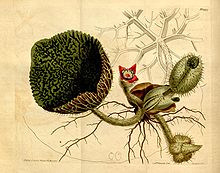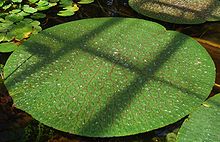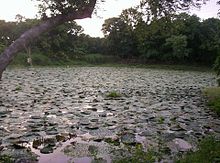bio.wikisort.org - Plant
Euryale ferox, commonly known as prickly waterlily[1] or Gorgon plant, is a species of water lily found in southern and eastern Asia, and the only extant member of the genus Euryale.[lower-alpha 1] The edible seeds, called fox nuts or makhana when dried,[2][lower-alpha 2] are eaten in Asia.
| Euryale ferox | |
|---|---|
 | |
| Illustration of Euryale ferox from Curtis's Botanical Magazine (1812). | |
| Scientific classification | |
| Kingdom: | Plantae |
| Clade: | Tracheophytes |
| Clade: | Angiosperms |
| Order: | Nymphaeales |
| Family: | Nymphaeaceae |
| Genus: | Euryale Salisb. |
| Species: | E. ferox |
| Binomial name | |
| Euryale ferox | |


Though normally classified in the water lily family, Nymphaeaceae, the species is occasionally regarded as a distinct family, Euryalaceae. Unlike other water lilies, the pollen grains of Euryale have three nuclei.[3]
Etymology
The genus is named after a mythical Greek Gorgon, Euryale.[4]
Growth
This section needs additional citations for verification. (November 2021) |
Euryale ferox is a perennial plant native to eastern Asia and southern Asia, and is found from northeast India[lower-alpha 3] to Korea and Japan, as well as parts of eastern Russia. The Indian state of Bihar produces 90% of the world's fox nuts.[5] It grows in water, producing bright purple flowers. The leaves are large and round, often more than a meter (3 feet) across, with a leaf stalk attached in the centre of the lower surface. The underside of the leaf is purplish, while the upper surface is green. The leaves have a quilted texture, although the stems, flowers, and leaves which float on the surface are covered in sharp prickles. Other leaves are submerged. In India, Euryale normally grows in ponds and wetlands.
Uses
This section needs additional citations for verification. (March 2019) |
Culinary
The plant produces starchy white seeds that are edible. The plant is cultivated for its seeds[5] in lowland ponds in India, China, and Japan. The Chinese have cultivated the plant for centuries.[6] More than 96,000 hectares of Bihar, India, were set aside for cultivation of Euryale in 1990–1991.[4] The plant grows best in locations with hot, dry summers and cold winters. Seeds are collected in the late summer and early autumn, and may be eaten raw or cooked.
In India, in the northern and western parts of the country, Euryale ferox seeds are often roasted or fried, which causes them to pop like popcorn.[7] These are then eaten, often with a sprinkling of oil and spices. It is used in cooking, especially to make a porridge or pudding called kheer.
Evidence from archaeobotany indicates that Euryale ferox was a frequently collected wild food source during the Neolithic period in the Yangtze region, with large numbers of finds coming from the sites of Kuahuqiao, Hemudu, and Tianluoshan.[8] The earliest recorded use of E. ferox was found in Gesher Benot Ya'aqov, Israel, among artifacts of the Acheulean culture 790–750,000 years ago.[9]
The seeds are used in Cantonese soup.[10]
Traditional medicine
The seeds of foxnut are used in Ayurveda preparations and in traditional Chinese medicine.[5]
Notes
- The plant is also called foxnut. Known as thangjing in parts of Manipur, India.
- Also called gorgon nut.
- Euryale is found in the Mithila region, specifically nine districts of Bihar (Madhubani, Darbhanga, Katihar, Sitamarhi, Purnea, Kishanganj, Araria, Saharsa and Supaul) and some hilly areas of Manipur.
References
- Lee, Sangtae; Chang, Kae Sun, eds. (2015). English Names for Korean Native Plants (PDF). Pocheon: Korea National Arboretum. p. 466. ISBN 978-89-97450-98-5. Retrieved 7 March 2019 – via Korea Forest Service.
- "Do you know where makhana grows? Know some facts and health benefits of this healthy food". Indian Express. July 20, 2019. Retrieved 15 March 2021.
- Cronquist, Arthur (1981). An Integrated System of Classification of Flowering Plants. New York: Columbia University Press. p. 111. ISBN 978-0-231-03880-5.
- Lariushin, Boriss (2012). Solanaceae family. p. 17. ISBN 9781478191834.
- Flora of China, "Euryale ferox"
- Mabberley, D. J. (1987). The Plant-book. Cambridge: Cambridge University Press. ISBN 978-0-521-34060-1.
- "Are popped lotus seeds the next popcorn?". Foodnavigator. Retrieved 2021-03-18.
- Fuller, D. Q.; Qin, L; Zheng, Y; Zhao, Z; Chen, X; Hosoya, LA; Sun, GP; et al. (2009). "The Domestication Process and Domestication Rate in Rice: Spikelet bases from the Lower Yangtze". Science. 323 (5921): 1607–1610. Bibcode:2009Sci...323.1607F. doi:10.1126/science.1166605. PMID 19299619. S2CID 21357179.
- Goren - Inbarand, N.; Melamed, Y.; Zohar, I.; Akhilesh, K.; Pappu, S. (2014-10-11). "Beneath Still Waters - Multistage Aquatic Exploitation of Euryale ferox (Salisb.) during the Acheulian". Internet Archaeology (37). doi:10.11141/ia.37.1. Retrieved 16 October 2014.
- Yujing Liu; et al. (2018). "Plants traditionally used to make Cantonese slow-cooked soup in China". Journal of Ethnobiology and Ethnomedicine. 14 (1): 4. doi:10.1186/s13002-018-0206-y. PMC 5769313. PMID 29334976.
Further reading
- Jha, S.N. (1999). "Physical and Hygroscopic Properties of Makhana". Journal of Agricultural Engineering Research. 72 (2): 145–150. doi:10.1006/jaer.1998.0356.
- Verma, Arvind Kumar; Banerji, B. K.; Chakrabarty, Debasis; Datta, S. K. (2010). "Studies on Makhana (Euryale ferox Salisbury)". Current Science. 99 (6): 795–800. ISSN 0011-3891. JSTOR 24109608.
- Bhardwaj, Tarun (August 22, 2022). "Bihar Mithila Makhana awarded GI Tag! Know about this variety of Fox Nut and its benefits". Financial Express. The Indian Express.
External links
- "Euryale ferox". Germplasm Resources Information Network (GRIN). Agricultural Research Service (ARS), United States Department of Agriculture (USDA).
На других языках
- [en] Euryale ferox
[es] Euryale ferox
Euryale ferox Salisb., 1805 es una especie de hierbas anuales o perennes acuáticas y pertenece a la familia Nymphaeaceae. Es un nenúfar gigante, similar a las especies de Victoria de América meridional.[ru] Эвриала (растение)
Эвриа́ла устраша́ющая (лат. Euryale ferox) — однолетнее пресноводное растение с плавающими листьями. Единственный вид монотипного рода Эвриала семейства Кувшинковые. Распространена в Азии, в том числе на российском Дальнем Востоке. В России является охраняемым видом.Другой контент может иметь иную лицензию. Перед использованием материалов сайта WikiSort.org внимательно изучите правила лицензирования конкретных элементов наполнения сайта.
WikiSort.org - проект по пересортировке и дополнению контента Википедии